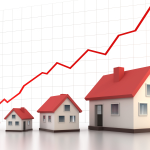 A number of housing stocks saw respectable gains on yesterday (Wednesday) as an important metric showed rising home sales. Pulte (PHM), Ryland (RYL), D.R Horton (DHI), NVR (NVR), Hovanian (HOV), and KB Homes (KBH) saw strong price appreciation after the National Association of Realtors said that pending home sales rose by 4.5% in January, the highest rate since April 2010.
A number of housing stocks saw respectable gains on yesterday (Wednesday) as an important metric showed rising home sales. Pulte (PHM), Ryland (RYL), D.R Horton (DHI), NVR (NVR), Hovanian (HOV), and KB Homes (KBH) saw strong price appreciation after the National Association of Realtors said that pending home sales rose by 4.5% in January, the highest rate since April 2010.
The uptick in stock prices was mostly modest (although HOV was up over 5%), as it should be. It is a modest metric, partly seasonally adjusted (which introduces room for error) and partly immodest in its results. April 2010 isn’t exactly a high point in the history of the United States economy, and sales rising to that level indicate what most investors already assume to be the case: the economy is recovering, sluggishly.
Another important housing metric is more encouraging. According to the S&P Case-Shiller index, home prices rose in December, meaning that home values in 2012 rose for the full year by 7.3% nationwide. This is great news for the U.S. economy, and just good news for homebuilders. There is still a lot of inventory, a lot of home sales are existing homes, and a lot of overdevelopment last decade is putting pressure on where companies like PHM, RYL, and so on can build.
The growth of home prices has much deeper effects than simply raising homebuilders’ stock, which is why this particular metric is worth paying close attention to–and why it made equities rise on Wednesday. Rising home prices is usually seen as a barometer for a healthy economy; even pre-crash, investors would look at the changing value of homes as a macroeconomic sign to buy or sell. Of course, since the crash, the importance of this particular sign of economic health has grown in proportion, so any change is going to move the needle.
Beyond a general sign of economic health, rising home prices might change consumer behavior. The rationale is simple: people own homes, and usually have some equity in their homes. Rising home prices equal more equity without extra payments, so it is essentially free money (or the feeling of having free money, at least) just for living in and owning your own house. That sense of getting free money–of having greater wealth–will raise consumer confidence, thus lifting consumer spending, and so the tide will rise for all boats. Retail, cyclicals, industrials, energy, and so on will see their stocks rise. Hence the overall, equity market rise on strong home price growth.
Thus home price metrics are more important than home sales metrics, because they are an early indicator of consumer behavior above and beyond the housing market. But since 2008, the home sales metric–especially the home sales to main occupant buyer metric (a rarely used, rarely publicized, and never agreed-upon figure)–has become very important. More home sales suggest the housing market is recovering and, as a result, home prices will rise. Thus home sales have become an important and indirect barometer of how the housing recovery is shaping up.
Both are strong but not very strong, so equities have risen modestly to where they were a couple weeks ago. Another real breakthrough–relief from Europe, direct metrics of growing consumer spending growth, or lower unemployment–will be needed before the DJI can reach its 2007 high, or before we can say that an economic recovery is fully and confidently here to stay.
